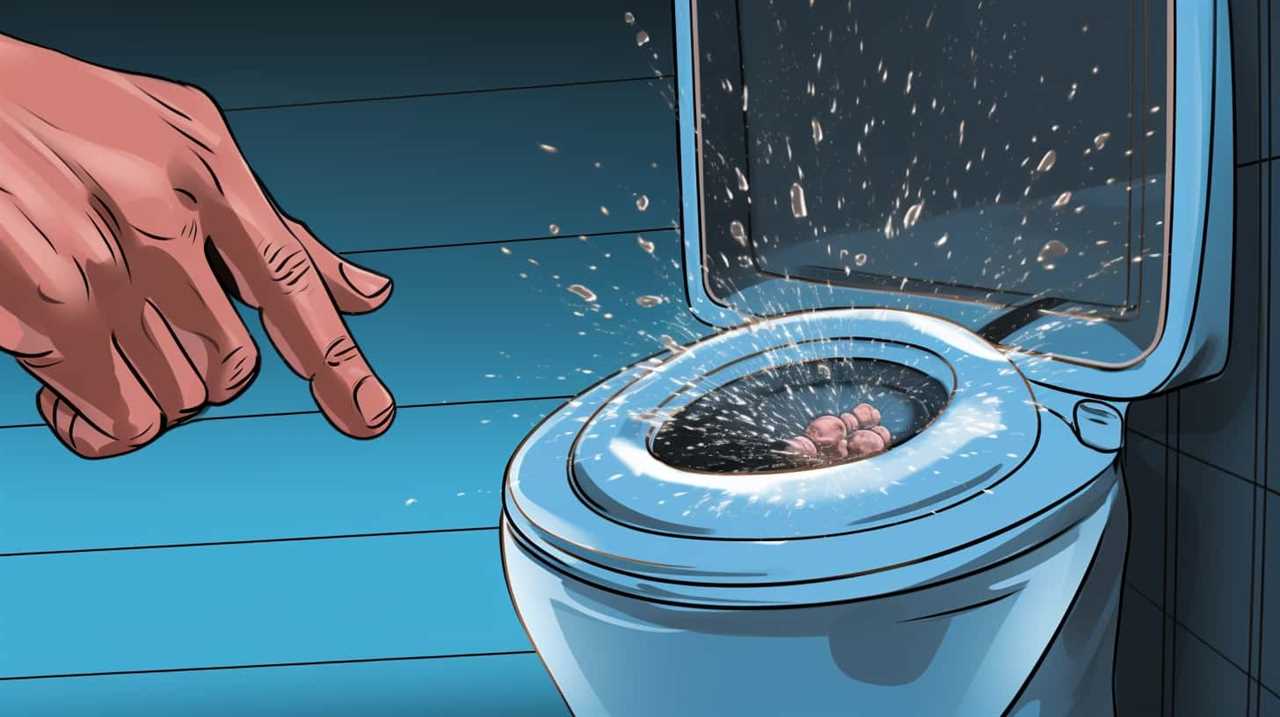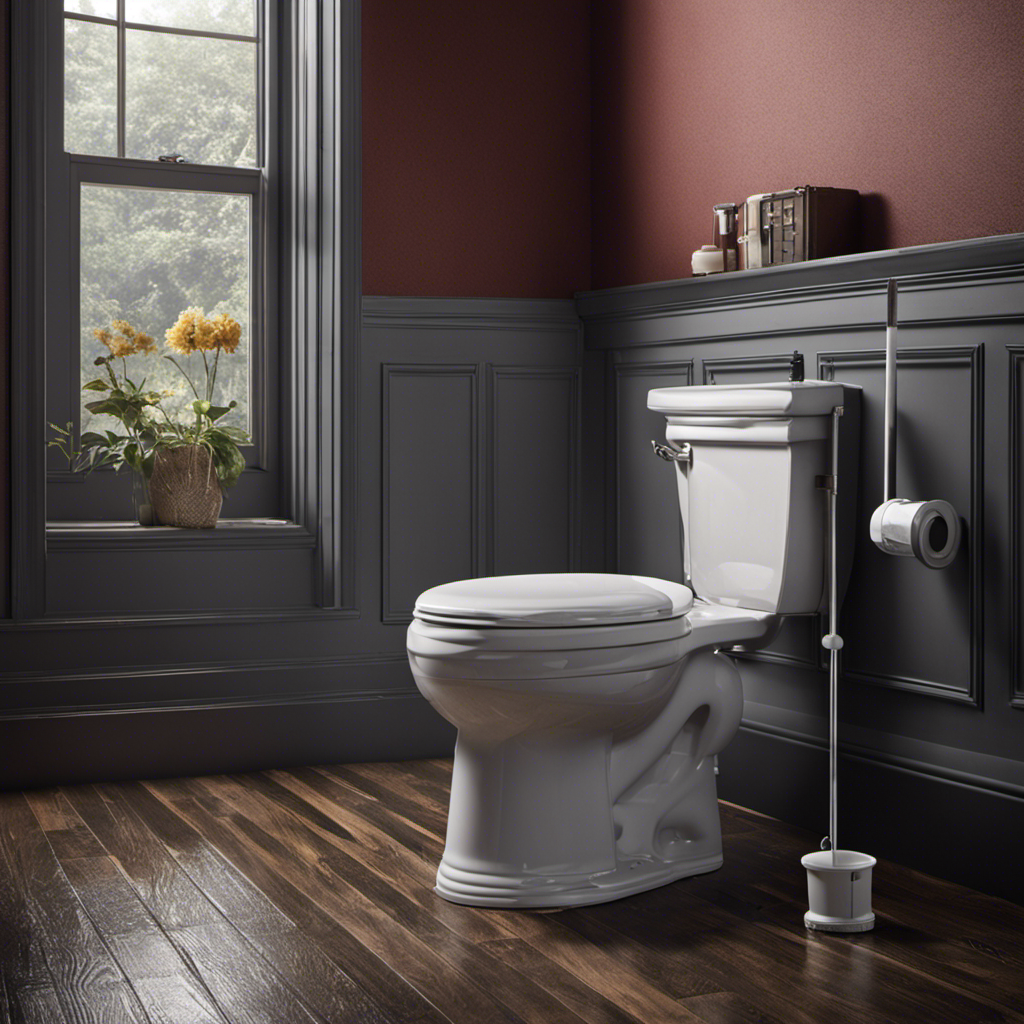Did you know that an overflowing toilet can cause an average of $2,000 in water damage?
As someone who has dealt with this frustrating and costly situation before, I understand the urgency and the need for a quick solution.
In this article, I will share my expertise and guide you through the step-by-step process of unclogging an overflowing toilet.
With the right tools and knowledge, you can save yourself from unnecessary stress and expenses.
Let’s get started.
Key Takeaways
- Understanding the causes and importance of toilet overflow
- Assessing and identifying the severity of the overflow
- Methods for identifying and clearing potential blockages
- Preventing future toilet overflows and maintenance
Understanding the Causes of Toilet Overflow
To understand why your toilet is overflowing, you’ll need to know the common causes of this issue.
There are several factors that can lead to a toilet overflow. One of the main causes is a clog in the drain pipe. This can occur when too much toilet paper or other foreign objects are flushed down the toilet.
Another cause is a faulty fill valve or float mechanism, which can result in the tank overfilling and causing the toilet to overflow.
Additionally, a sewer line blockage or a malfunctioning toilet flapper can also contribute to an overflowing toilet.
To prevent toilet overflow, it is important to avoid flushing excessive amounts of toilet paper or non-flushable items. Regular maintenance, such as checking and replacing faulty components, can also help prevent this issue.
Assessing the Severity of the Overflow
When it comes to assessing the severity of a toilet overflow, there are several key points to consider.
The first step is identifying potential blockages, such as toilet paper or foreign objects, that may be causing the backup.
Next, it is important to assess the water level in the toilet bowl and determine if it is steadily rising or already at its maximum capacity.
Lastly, evaluating backup causes, such as a clogged sewer line or a malfunctioning flush valve, can help determine the extent of the problem and guide the appropriate course of action.
Identifying Potential Blockages
You’ll want to first check for any visible obstructions in the toilet bowl. This is a common step to identify potential blockages that may be causing the overflow. Here are some common signs to look out for and potential solutions:
| Signs | Potential Solutions |
|---|---|
| Water rising to the rim | Use a plunger to dislodge the blockage. If that doesn’t work, try using a toilet auger. |
| Gurgling sounds | The blockage may be further down the drain. Try using a drain snake to remove it. |
| Slow draining | The blockage may not be completely clogging the pipe. Use a mixture of hot water and dish soap or a chemical drain cleaner to dissolve it. |
| Foul odor | The blockage may be causing a sewage backup. In this case, you may need to call a professional plumber to assess and fix the issue. |
Assessing Water Level
First, check the water level in the toilet bowl to determine the severity of the issue.
Evaluating water damage and determining the water flow are crucial steps in assessing the situation.
Start by observing the water level in the bowl. If it is close to overflowing or already overflowing, the clog may be significant. This could indicate a blockage further down the drainpipe or a problem with the plumbing system.
Alternatively, if the water level is low or normal, the clog might be closer to the surface or easily removable. Understanding the water level helps in determining the appropriate course of action to unclog the toilet.
Now, let’s move on to evaluating backup causes and identifying potential solutions.
Evaluating Backup Causes
Now, let’s assess the potential causes of backup and identify possible solutions.
When evaluating backup solutions, it is crucial to look for signs of a clogged drain. One common cause of backup is the accumulation of debris in the pipes, such as hair, grease, or foreign objects. These can obstruct the flow of water and lead to backups.
Another possible cause is tree roots infiltrating the sewer lines, causing blockages and backups. To evaluate the backup causes accurately, it is essential to inspect the toilet, sink, and shower drains for any signs of slow drainage or gurgling noises. Additionally, foul odors emanating from the drains can indicate a clog.
Once the backup causes have been identified, appropriate solutions can be implemented, such as using a drain snake or seeking professional assistance to remove the clog and restore proper flow.
Gathering the Necessary Tools and Supplies
To gather the necessary tools and supplies for unclogging an overflowing toilet, make sure you have a plunger and a bucket. These two items are essential for tackling any toilet repair or emergency plumbing situation.
The plunger is specifically designed to create pressure and suction, which helps to dislodge any clogs in the toilet drain. Look for a plunger with a flange, as it provides a better seal and increases the effectiveness of the plunging action.
The bucket is useful for catching any excess water that may spill during the unclogging process. Additionally, it can be used to hold cleaning supplies or to transport water if needed.
Step-by-Step Guide to Unclogging the Toilet
When it comes to unclogging a toilet, there are two main tools that can be used: a plunger or a snake. The choice between the two depends on the severity and nature of the clog.
A plunger is typically used for minor clogs, while a snake is more effective for stubborn or deeper clogs.
Additionally, controlling the water level in the toilet bowl is crucial during the unclogging process. This can help prevent overflow and ensure proper suction or maneuvering of the tools.
Plunger or Snake
If you’re dealing with an overflowing toilet, grab a plunger or snake to clear the clog. When it comes to unclogging a toilet, using the right tools and techniques is crucial.
Let’s start with the plunger technique. First, make sure there is enough water in the bowl to cover the suction cup of the plunger. Place the plunger over the drain hole and create a tight seal. Push down firmly and then pull up quickly, repeating this motion several times. The suction created by the plunger should help dislodge the clog.
If the plunger doesn’t work, it’s time to turn to the snake. Insert the snake into the drain hole and twist it clockwise to break up the clog. Pull the snake out and flush the toilet to see if the clog is cleared. Remember to always wear gloves and use caution when using a snake.
Water Level Control
Using the plunger or snake method, it’s important to ensure there is enough water in the bowl to cover the suction cup. This helps create a seal and allows for effective unclogging. However, it’s equally important to prevent overflow during the process. To achieve this, a water level adjustment can be made. By adjusting the water level in the toilet bowl, you can control the amount of water that flows into the sewer line. This can help prevent any potential overflow while you unclog the toilet. Below is a table that provides a step-by-step guide on how to adjust the water level in the toilet bowl:
| Step | Action | Result |
|---|---|---|
| 1 | Locate the water level adjust | Allows you to control water level |
| 2 | Turn the adjuster clockwise | Raises water level |
| 3 | Turn the adjuster counter | Lowers water level |
| 4 | Observe the water level | Adjust until it is at a safe and desired level |
Preventing Future Toilet Overflows
To prevent future toilet overflows, you should regularly check for any signs of clogging and avoid flushing excessive amounts of toilet paper.
One of the most important toilet maintenance tips is to be mindful of what you flush down the toilet. Flushing large amounts of toilet paper at once can easily cause a clog and lead to an overflow. Additionally, avoid flushing any non-flushable items, such as wipes or feminine hygiene products, as they can also cause blockages.
Another helpful tip is to periodically check the water flow in your toilet. If you notice that the water is flowing slowly or not draining properly, it could indicate a clog that needs to be addressed.
Troubleshooting Common Toilet Clogging Issues
One common issue you may encounter with your toilet is when it doesn’t flush properly. Troubleshooting this problem requires a bit of knowledge and technical expertise.
When your toilet doesn’t flush as it should, there are a few possible causes to consider. First, check for any leaks around the toilet base or the water supply line. Leaks can prevent the toilet from flushing properly and lead to water damage. If you notice any leaks, you can attempt a DIY toilet repair by tightening the bolts or replacing the wax seal.
Another common cause of a faulty flush is a clogged toilet drain. In this case, you can try using a plunger or a toilet auger to clear the blockage.
Remember to always exercise caution and follow proper safety procedures when troubleshooting toilet issues.
Frequently Asked Questions
Can I Use Any Household Item to Unclog a Toilet?
Yes, you can use various household items as alternatives to a toilet plunger. Some options include a wire hanger, hot water and dish soap, or a wet/dry vacuum. These methods can help unclog a toilet effectively.
How Long Does It Usually Take to Unclog an Overflowing Toilet?
On average, it takes about 15-30 minutes to unclog an overflowing toilet. There are several effective techniques, such as using a plunger or a toilet auger, which can quickly resolve the issue.
Are There Any Health Risks Associated With Toilet Overflow?
Health risks associated with toilet overflow can include the spread of bacteria and pathogens, which can lead to illness and infection. Prevention methods, such as regular maintenance and proper use, can help mitigate these risks.
Can I Use Chemical Drain Cleaners to Unclog a Toilet?
I wouldn’t recommend using chemical drain cleaners to unclog a toilet. There are safer and more effective toilet unclogging methods available, such as using a plunger or a toilet auger. These alternatives are less likely to cause damage or harm.
What Should I Do if the Toilet Keeps Overflowing Even After Following the Steps to Unclog It?
When the toilet keeps overflowing despite following the steps to unclog it, it’s time to consider alternative solutions. If all else fails, don’t hesitate to call a professional for expert assistance.
Conclusion
In conclusion, unclogging an overflowing toilet can be a messy and unpleasant task, but with the right tools and knowledge, it can be easily resolved. By understanding the causes of toilet overflow and assessing the severity of the issue, you can effectively address the problem.
Additionally, taking preventative measures such as proper flushing and avoiding flushing non-flushable items can help avoid future toilet overflows.
Interestingly, did you know that according to a study conducted by the American Water Works Association, toilet clogs account for approximately 20% of all residential plumbing problems? This statistic highlights the importance of knowing how to unclog a toilet effectively.










